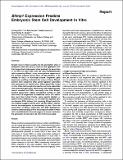| dc.contributor.author | Chu, Li-Fang | |
| dc.contributor.author | Surani, M. Azim | |
| dc.contributor.author | Jaenisch, Rudolf | |
| dc.contributor.author | Zwaka, Thomas P. | |
| dc.date.accessioned | 2014-12-16T22:51:44Z | |
| dc.date.available | 2014-12-16T22:51:44Z | |
| dc.date.issued | 2011-10 | |
| dc.date.submitted | 2011-08 | |
| dc.identifier.issn | 09609822 | |
| dc.identifier.issn | 1879-0445 | |
| dc.identifier.uri | http://hdl.handle.net/1721.1/92356 | |
| dc.description.abstract | Despite recent critical insights into the pluripotent state of embryonic stem cells (ESCs), there is little agreement over the inaugural and subsequent steps leading to its generation [1, 2, 3 and 4]. Here we show that inner cell mass (ICM)-generated cells expressing Blimp1, a key transcriptional repressor of the somatic program during germ cell specification [5 and 6], emerge on day 2 of blastocyst culture. Single-cell gene expression profiling indicated that many of these Blimp1-positive cells coexpress other genes typically associated with early germ cell specification. When genetically traced in vitro, these cells acquired properties normally associated with primordial germ cells. Importantly, fate-mapping experiments revealed that ESCs commonly arise from Blimp1-positive precursors; indeed, prospective sorting of such cells from ICM outgrowths increased the rate of ESC derivation more than 9-fold. Finally, using genetic ablation or distinct small molecules [7 and 8], we show that epiblast cells can become ESCs without first acquiring Blimp1 positivity. Our findings suggest that the germ cell-like state is facultative for the stabilization of pluripotency in vitro. Thus, the association of Blimp1 expression with ESC development furthers understanding of how the pluripotent state of these cells is established in vitro and suggests a means to enhance the generation of new stem cell lines from blastocysts. | en_US |
| dc.description.sponsorship | Huffington Foundation | en_US |
| dc.description.sponsorship | National Institutes of Health (U.S.) (Grant R01 EB005173-01) | en_US |
| dc.description.sponsorship | National Institutes of Health (U.S.) (Grant 1R01 GM077442-01) | en_US |
| dc.description.sponsorship | National Institutes of Health (U.S.) (Grant P20 EB007076) | en_US |
| dc.description.sponsorship | National Institutes of Health (U.S.) (Grant P01 GM81627) | en_US |
| dc.language.iso | en_US | |
| dc.publisher | Elsevier | en_US |
| dc.relation.isversionof | http://dx.doi.org/10.1016/j.cub.2011.09.010 | en_US |
| dc.rights | Article is made available in accordance with the publisher's policy and may be subject to US copyright law. Please refer to the publisher's site for terms of use. | en_US |
| dc.source | Elsevier | en_US |
| dc.title | Blimp1 Expression Predicts Embryonic Stem Cell Development In Vitro | en_US |
| dc.type | Article | en_US |
| dc.identifier.citation | Chu, Li-Fang, M. Azim Surani, Rudolf Jaenisch, and Thomas P. Zwaka. “Blimp1 Expression Predicts Embryonic Stem Cell Development In Vitro.” Current Biology 21, no. 20 (October 2011): 1759–1765. © 2011 Elsevier Ltd. | en_US |
| dc.contributor.department | Massachusetts Institute of Technology. Department of Biology | en_US |
| dc.contributor.department | Whitehead Institute for Biomedical Research | en_US |
| dc.contributor.mitauthor | Jaenisch, Rudolf | en_US |
| dc.relation.journal | Current Biology | en_US |
| dc.eprint.version | Final published version | en_US |
| dc.type.uri | http://purl.org/eprint/type/JournalArticle | en_US |
| eprint.status | http://purl.org/eprint/status/PeerReviewed | en_US |
| dspace.orderedauthors | Chu, Li-Fang; Surani, M. Azim; Jaenisch, Rudolf; Zwaka, Thomas P. | en_US |
| mit.license | PUBLISHER_POLICY | en_US |
| mit.metadata.status | Complete | |
